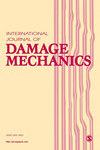改性橡胶水泥稳定土力学性能及损伤演化研究
IF 3.9
2区 工程技术
Q2 MATERIALS SCIENCE, MULTIDISCIPLINARY
引用次数: 0
摘要
采用真空加热和水泥预涂两种改性方法对橡胶颗粒的体硬化和表面处理进行了优化。通过橡胶硬度测试、水接触角评估、傅里叶变换红外光谱等对真空加热改性橡胶的理化特性进行综合评价。采用无侧限抗压强度(UCS)试验结合数字图像相关技术对改性橡胶水泥土(RCS)试件的强度提升和损伤演化机制进行了评价,并利用扫描电镜对改性橡胶水泥土的微观结构破坏机制进行了进一步表征。通过显著性分析和不同修正参数下RCS强度数据的非线性曲面拟合,验证了两种方法的有效性。实验结果表明,真空加热使橡胶硬度提高34.6%,水接触角降低16.1°,显著提高了RCS的UCS。真空加热方法可以提高试样的内聚性和结构连续性,而水泥预涂覆试样在不牺牲材料韧性的情况下获得强度提高。上述两种方法都成功地促进了橡胶颗粒在水泥稳定土基质中的整合。本文章由计算机程序翻译,如有差异,请以英文原文为准。
Study on mechanical properties and damage evolution of modified rubberized cement stabilized soil
Two modification approaches, namely vacuum heating and cement precoating, were applied to optimize the bulk hardening and surface treatment of rubber particles. The physicochemical characteristics of vacuum-heated modified rubber underwent comprehensive evaluation through rubber hardness testing, water contact angle assessments, and Fourier transform infrared spectroscopy. Unconfined compressive strength (UCS) tests combined with digital image correlation techniques were utilized to evaluate the strength improvement and damage evolution mechanism in modified rubber cement stabilized soil (RCS) specimens, while scanning electron microscopy was used to further characterize the microstructural failure mechanisms of modified RCS. The effectiveness of both methods was validated through significance analysis and nonlinear surface fitting of RCS strength data under varying modification parameters. Experimental results revealed that vacuum heating elevated rubber hardness by 34.6% and decreased water contact angle by 16.1° relative to untreated controls, significantly enhancing the UCS of RCS. The vacuum heating method could improve the cohesive properties and structural continuity of specimens, whereas cement precoated samples achieved strength gains without sacrificing material toughness. Both of the above two methods successfully facilitated rubber particle integration within the cement-stabilized soil matrix.
求助全文
通过发布文献求助,成功后即可免费获取论文全文。
去求助
来源期刊

International Journal of Damage Mechanics
工程技术-材料科学:综合
CiteScore
8.70
自引率
26.20%
发文量
48
审稿时长
5.4 months
期刊介绍:
Featuring original, peer-reviewed papers by leading specialists from around the world, the International Journal of Damage Mechanics covers new developments in the science and engineering of fracture and damage mechanics.
Devoted to the prompt publication of original papers reporting the results of experimental or theoretical work on any aspect of research in the mechanics of fracture and damage assessment, the journal provides an effective mechanism to disseminate information not only within the research community but also between the reseach laboratory and industrial design department.
The journal also promotes and contributes to development of the concept of damage mechanics. This journal is a member of the Committee on Publication Ethics (COPE).
 求助内容:
求助内容: 应助结果提醒方式:
应助结果提醒方式:


